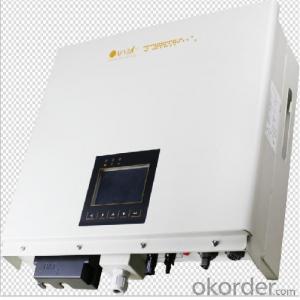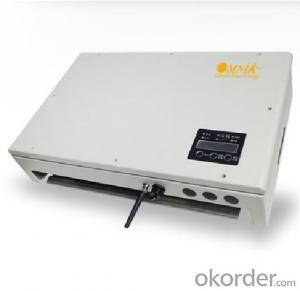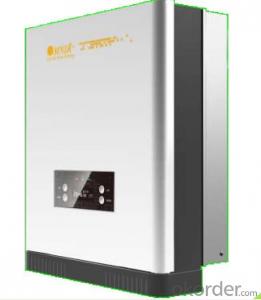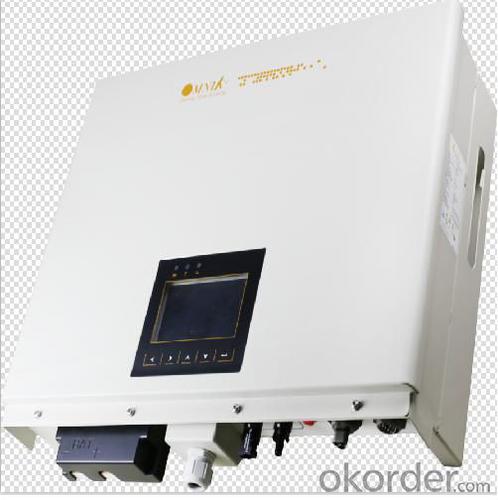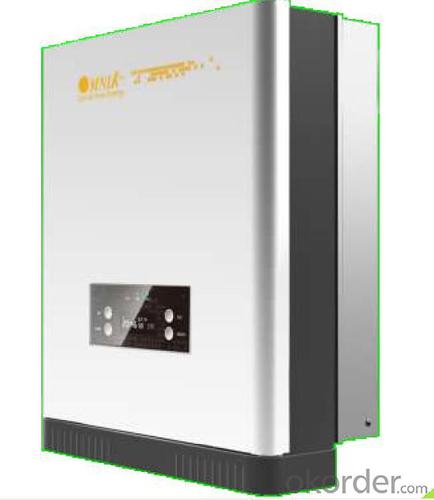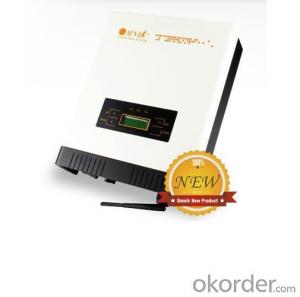Rv Solar Inverter Omniksol-5.0K-JP
- Loading Port:
- Shanghai
- Payment Terms:
- TT OR LC
- Min Order Qty:
- 5 pc
- Supply Capability:
- 3000 pc/month
OKorder Service Pledge
OKorder Financial Service
You Might Also Like
Omnik new energy solar inverter
Omniksol-2.0k-TL Photon Efficiency up to 3kW
in the world------ Photon tested Jan. 2012.
Omniksol-5k-JP
1.Futures
Omniksol-4k-JP PV inverter ,featuring two MPPT tracker, maximum converstaion efficiency 96.2%,off-grid to on grid mutual switch , IP 65 Protection design, easy installation , is special designed for Janpan consumer.
Features
Transformer design, high frequency isolation technology with high security
High efficiency (Max.96.2%), High MPPT accuracy(>99.9%)
2 MPPT design, reach the maximum output power
Wide DC input range (95-420 Vdc),lower start voltage 65Vdc
on-grid/ off grid switch function
IP 65 design, suitable for indoor and outdoor installation
10 years warranty(10~25 years as option)
2.Technical data:
Inverter Type | Omniksol-3k-TL | Omniksol-4k-TL | Omniksol-5k-TL | |
| Input(DC) | Max.PV Input voltage[V] | 450 | ||
| Input Voltage Range(MPPT)[V] | 95-420 | |||
| Operation voltage Range[V] | 75-420 | |||
| Rating Input voltage[V] | 280 | |||
| Wake Up voltage[V] | 65 | |||
| Number of MPPT Trackers | 2 | |||
| Input Power Limitation[W] | 1600 | 2100 | 2600 | |
| Input Current Limitation[A] | 8 | 10 | 12 | |
| MPPT Efficiency | 99.90% | |||
| Efficiency | >96% | >96% | >96.2% | |
| Input Switch[A] | 8 | 10 | 12 | |
3. On grid solar inverter Omniksol-5.0k- JP Certificate
JET
CE
4. On grid solar inverter Omniksol-5.0k- JP outlook
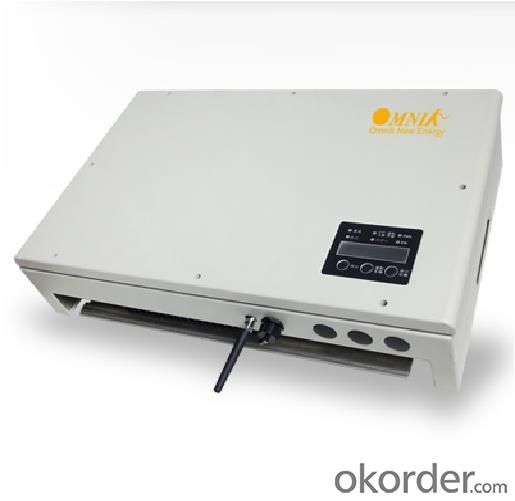
- Q: Is it possible to monitor the performance of a solar inverter remotely?
- Yes, it is possible to monitor the performance of a solar inverter remotely. Many modern solar inverters come with built-in monitoring capabilities that allow users to track and analyze the system's performance from a remote location. This can be done through dedicated monitoring portals or mobile applications which provide real-time data on energy production, system efficiency, and any potential issues or faults. Remote monitoring enables users to optimize the performance of their solar inverter, identify any maintenance or operational requirements, and ensure the system is operating at its maximum potential.
- Q: How does a solar inverter handle low light conditions?
- A solar inverter handles low light conditions by continuously monitoring the amount of sunlight received by the solar panels. When light levels drop, the inverter adjusts its operation to maximize power output by optimizing the voltage and current levels. It uses advanced algorithms and power electronics to convert the available sunlight into usable electricity efficiently, ensuring that even in low light conditions, the solar system continues to generate power.
- Q: Can a solar inverter be used for residential applications?
- Yes, a solar inverter can be used for residential applications. In fact, it is commonly used in residential solar power systems to convert the direct current (DC) generated by solar panels into alternating current (AC) that can be used to power household appliances and electronics.
- Q: Can a solar inverter be used with a three-phase power system?
- Yes, a solar inverter can be used with a three-phase power system. In fact, most modern solar inverters are designed to work with both single-phase and three-phase power systems.
- Q: What is the role of a power limiter in a solar inverter?
- The role of a power limiter in a solar inverter is to regulate and limit the amount of power that can be generated and fed back into the electrical grid. It ensures that the solar system does not exceed the permitted power limits set by the utility company or regulatory authorities, preventing any potential damage to the grid infrastructure. Additionally, a power limiter helps maintain a stable and reliable power supply by controlling the amount of solar energy that is being exported or utilized within a specific threshold.
- Q: How does a solar inverter handle different temperature conditions?
- A solar inverter is designed to handle different temperature conditions by incorporating various features and mechanisms. Firstly, it is equipped with a temperature sensor that continuously monitors the inverter's internal temperature. If the temperature exceeds a certain threshold, the inverter activates cooling mechanisms such as fans or heatsinks to dissipate the heat and prevent overheating. Additionally, the inverter's components are selected and designed to withstand a wide range of temperatures, ensuring their functionality and longevity even in extreme conditions. Furthermore, modern inverters often have built-in protective measures like thermal derating, which reduces the inverter's power output as the temperature rises, ensuring it operates within safe limits. Overall, solar inverters are engineered to adapt and operate efficiently in varying temperature conditions for optimal performance and reliability.
- Q: Can a solar inverter be used with a solar carport?
- Yes, a solar inverter can be used with a solar carport. A solar inverter is responsible for converting the direct current (DC) produced by the solar panels into usable alternating current (AC) electricity. This AC electricity can then be used to power various devices or fed back into the grid. In the case of a solar carport, the solar panels installed on the carport structure generate DC electricity, which is converted by the solar inverter into AC electricity to charge electric vehicles or power other electrical systems in the carport.
- Q: Can a solar inverter be used in remote areas?
- Yes, a solar inverter can be used in remote areas. Solar inverters are designed to convert the direct current (DC) generated by solar panels into alternating current (AC) that can be used to power electrical devices. As long as there is access to sunlight, solar panels can be installed in remote areas to generate electricity, and the solar inverter can then be used to convert and distribute that power for various applications. This makes solar inverters a useful and sustainable solution for remote areas that may not have access to grid electricity.
- Q: Can a solar inverter be used with a solar-powered waste management system?
- Yes, a solar inverter can be used with a solar-powered waste management system. A solar inverter is used to convert the direct current (DC) electricity generated by solar panels into alternating current (AC) electricity that can be used to power various appliances and systems. In the case of a solar-powered waste management system, the solar inverter would be an essential component to convert the DC power generated by the solar panels into the AC power required to operate the waste management equipment.
- Q: Can a solar inverter be used with a single solar panel?
- Yes, a solar inverter can be used with a single solar panel. The purpose of a solar inverter is to convert the direct current (DC) generated by the solar panel into usable alternating current (AC) electricity. Whether you have one or multiple solar panels, a solar inverter is necessary to convert the DC power into AC power that can be used to power electrical appliances or be fed back into the grid.
Send your message to us
Rv Solar Inverter Omniksol-5.0K-JP
- Loading Port:
- Shanghai
- Payment Terms:
- TT OR LC
- Min Order Qty:
- 5 pc
- Supply Capability:
- 3000 pc/month
OKorder Service Pledge
OKorder Financial Service
Similar products
Hot products
Hot Searches
Related keywords
